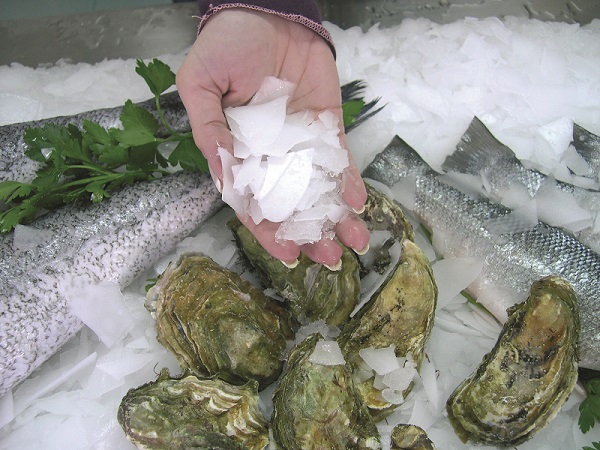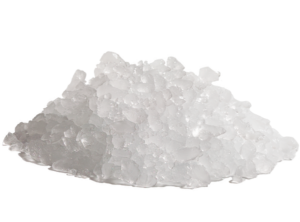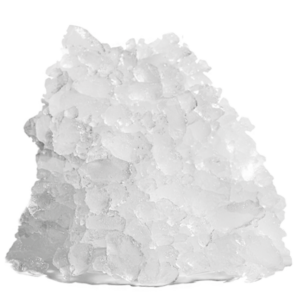Keeping perishable products at the right temperature implies certain particularities. Flake ice has become one of the most popular types due to its strength and the time required to make it.
Although it may seem like a small difference, this type of ice offers significant advantages compared to others. The key is that flake ice has a faster cooling effect, which makes it especially suitable for food preservation and refrigeration in large facilities.
The use of ice blocks for refrigeration is an ancient practice. Until the beginning of the last century, it was common for ice to be delivered to homes to supply the first refrigerators. In addition, there was an international trade in ice obtained from frozen lakes in certain areas of the United States. According to the Food and Agriculture Organization of the United Nations (FAO), the commercial manufacture of ice blocks began in 1869 and consisted of filling metal molds with water and immersing them in a brine solution refrigerated below the boiling point. water freezing. After several hours, the water would freeze and the ice blocks would be removed from the molds for storage.
The FAO also clarifies that the production of ice blocks is a batch process, as once the molds are empty, they are refilled with water and placed in the brine solution for another freezing period. “Regardless of the capacity of the machine, continuous labor is required to perform all operations, including ice removal and handling.”
In the same document another process for the manufacture of ice is described, with the aim of reducing the time required. Instead of immersing the molds in a brine solution, the water inside the molds is frozen by a coolant that circulates around the outside of each mold and through a system of piping that runs through the interior of the molds. In this way, ice forms simultaneously on all refrigerated surfaces in contact with water. Once the freeze cycle is complete, the blocks are quickly released from the molds by a hot gas thawing system and removed by gravity.
On the other hand, flake ice is produced in a different way and has very specific characteristics. It is a type of fragmented ice, cooled to very low temperatures and dry , which causes the water to be below the freezing point. Under normal conditions, it is at 0 °C, but in this process it drops to -7 °C, which gives it better heat transfer properties. In addition, its size, which ranges from 5 to 10 square centimeters and has a thickness of 1.5 to 3 mm, provides the advantage of covering a greater surface area and achieving better contact with the products to be cooled, according to Alejandro Vargas, engineer and regional sales manager for the Pacific area and product manager for FB ICE. In summary, due to its inherent characteristics, flake ice is more suitable for cooling and preserving perishable products.
According to the FAO, the advantages and disadvantages of flake ice are as follows:
- It has a larger heat exchange surface compared to other types of ice.
- Being slightly subcooled (between -5 and -7 °C), it can release 83 kcal per kg when it melts and becomes a liquid.
- It can extract more heat than other varieties of ice, which are at 0 °C (80 kcal per kg).
- It is easy to store and handle when you have a thermo-insulated container , subcooled to -5 °C and properly designed for storage.
- The machine is small and compact, requiring little space.
- Ice making begins shortly after starting the machine, allowing for almost “on demand” ice.
- The ice can be used immediately after its manufacture, without the need to crush it.
Considerations of the differente ice flake types
Ice in flakes is normally understood as ice which, unlike cubes, occurs in the form of small, irregularly shaped pieces.
Its main use has been, and continues to be, the preservation of fish, although it is increasingly being used for other applications such as bakeries, the meat industry, hospitals, gyms, laboratories…
The traditional method of obtaining it was by crushing ice into bars, this use is obsolete because it is economically and energetically inefficient. Currently it is manufactured using ice generators that continuously supply the ice flakes with productions from a few kg to tens of tons per day.
The different working systems of these generators mean that the ice obtained is also different, and although we include it all as flake ice, its properties vary significantly.
The main differences are found in:
- The shape and size of the pieces.
- The temperature of the inner core of the scale.
- The percentage of humidity. Both the water retained in the ice mass and its surface wetting.
The main working systems of the generators are:
- Drum machines. Normally for large productions. Ice forms on a cylindrical surface, dries and is separated by mechanical means (blade or bur). Thin, subcooled and very dry sheets are produced .
- Spindle machines with pressing. The ice forms on the internal surface of a tube and is passed through nozzles that press, dry and chop it into small cylinders or sectors. The internal temperature is not as low as the first case, but it still presents hard shapes with sharp edges.
- Pressless spindle machines . Similar to the previous case, but the ice that forms inside the flooded tube is scraped and removed with a spindle without draining it. Generally small pieces with irregular size and shape are obtained; internal temperature very close to that of melting water and high internal and superficial humidity content.
For those who handle fresh fish in contact with ice it is well known that a low temperature of the scale produces a “burn” or thermal laceration of the skin. The hard particles with sharp edges cause, on the other hand, a mechanical abrasion that also deteriorates it.
The first two types are therefore not recommended for direct contact with fresh fish. The drawback of the third is that due to the water content, thermal storage in the form of latent heat is lower per Kg and therefore its persistence.
When we are talking about ice applications directly on human skin, all these considerations obviously take on greater importance.
It would therefore be a great inaccuracy to include all types of flake or crushed ice in the same bag when analyzing their use in these applications.
Types of flakes and crushed ice on ITV Ice Makers
IQ F
The IQF range produces Chip ice with 20% humidity, perfect for the food industry, hospitals, laboratories or spas.
IQ
The IQ series produces Diamond ice , designed for cocktails ; or Granular ice, ideal for supermarkets or transporting fish, fruit and vegetables.
SCALE
The SCALA series for flat flake ice has different versions depending on whether or not it includes the condensing unit or if it is connected remotely.
 10
10




